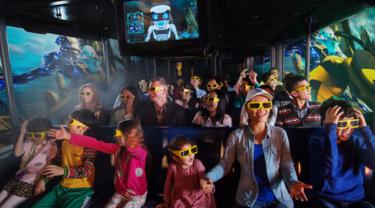Guy Nelson clearly remembers his birthday in 2007 – it was day the Empire Industries (EI) founder and CEO purchased Dynamic Structures and backed the company with a rich history of exports in both telescopes and amusement ride attractions.
Nelson first became aware of Port Coquitlam-based Dynamic Structures when EI, also a steel fabricator, was bidding for the steel contract for two Vancouver 2010 Olympic and Paralympic Winter Games projects. He recalls having to submit a very competitive bid to win the contract for the speed skating oval in Richmond, B.C. while Dynamic Structures won the contract for the ski jump in Whistler.
When the opportunity came to acquire its competitor, Nelson took it and bought Dynamic Structures from international engineering firm Amec.
Although Nelson says he would like to think there was some “grand design” in acquiring a company that ultimately formed the impetus to shift EI’s strategy from steel fabrication to the two niche sectors of telescopes and amusement park rides, it was a happy coincidence.
Much of Dynamic Structures’ competency in the engineering and the design field came from work the company had done in the telescopes sector since 1975.
“Those skill sets are transferable: if you really break it down, they were really making very large, complex precision equipment. Amusement rides fall into that category, it just happens to be a different end-market, so I decided to aggressively expand the use of that skill in a growing marketplace that happened to be an export market,” he says.
Nelson grew the business more than five-fold by exploiting those strengths in international markets. When EI acquired Dynamic Structures it had no export sales; in 2017 its exports are expected to account for 95 per cent of revenues, and the company is winding down its steel fabrication for third parties in Canada.
Nelson says the telescope side of Dynamic Structures’ business was not steady enough to cover the overheads needed in busy times.
“Telescopes are a huge project, but they may only come along once a decade,” he adds.
Currently the company is executing a $10-million contract awarded by the Canadian Commercial Corporation to build the enclosure for one of the world’s largest observatories, the Thirty Meter Telescope (TMT), to be sited on Hawaii’s Mauna Kea. Dynamic Structures has been actively working on the project since it was first envisaged more than 10 years ago and is part of an international consortium including Japan, China, India, and the United States building the TMT.
Dynamic Structures is responsible for the 55-metre high enclosure that will rotate and open directly over the telescope, enabling astronomers to study objects in our solar system and stars throughout the Milky Way and its neighbouring and forming galaxies.
“When you can say you’ve built more than half the world’s largest telescopes and that you’ve put these massive structures on top of mountaintops all over the world, and they stay in place and work for upwards of 40 years, that speaks a lot to a unique capability – that engineering challenge that we’ve been able to handle. I think that is part of our reputation. People come to us if they need to build complex machines that are large and difficult to put together. That’s a skill set that’s quite unique,” he says.
Nelson leveraged that skill set, plus the company’s credentials from doing work for Disney and Universal theme parks, to focus on the amusement ride business that serves a more predictable, growing and steady market. This initiative resulted in the establishment of Dynamic Attractions in 2011, a subsidiary that concentrates on marketing rides in the U.S., Europe, and especially China and the Middle East.
Recent projects include building L’Extraordinaire Voyage at Parc Futuroscope in France, based on the classic Jules Verne novel Around the World in 80 Days. Featuring Dynamic Attractions’ patent-pending Flying Theatre technology, the ride provides 84 passengers with an immersive flight experience set in scenes around the world, including a kite festival at the Taj Mahal and hot air ballooning over Yellowstone National Park.
Other 2016 projects were exported to South Korea, China, United Arab Emirates, and the U.S..
When it first entered the Chinese market, Dynamic partnered with a Chinese company.
“Everything about China was foreign to me,” says Nelson. “Having a partner there to work through the learning curve of doing business in China was helpful for that period of time.”
Now Dynamic has established a wholly owned foreign enterprise in China.
“We’ve matured, and are able to approach that market in a far more aggressive way than we could have five years ago,” he says.
Dynamic also makes use of Export Development Canada’s (EDC) services to support its export business.
“If we’re doing an export contract where we’re exporting something that we manufacture here in Canada, then we tend to protect our position during the contracting part with various products that EDC has, like receivable insurance and bad debt insurance. We also use their bonding facility to guarantee our performance to clients overseas,” he says.
Nelson adds that, “We can make dreams come true, but we have to be careful about which customers can afford to have their dreams realized. We are starting to find more and more that tends to be the people that are doing business in overseas markets,” he says.





